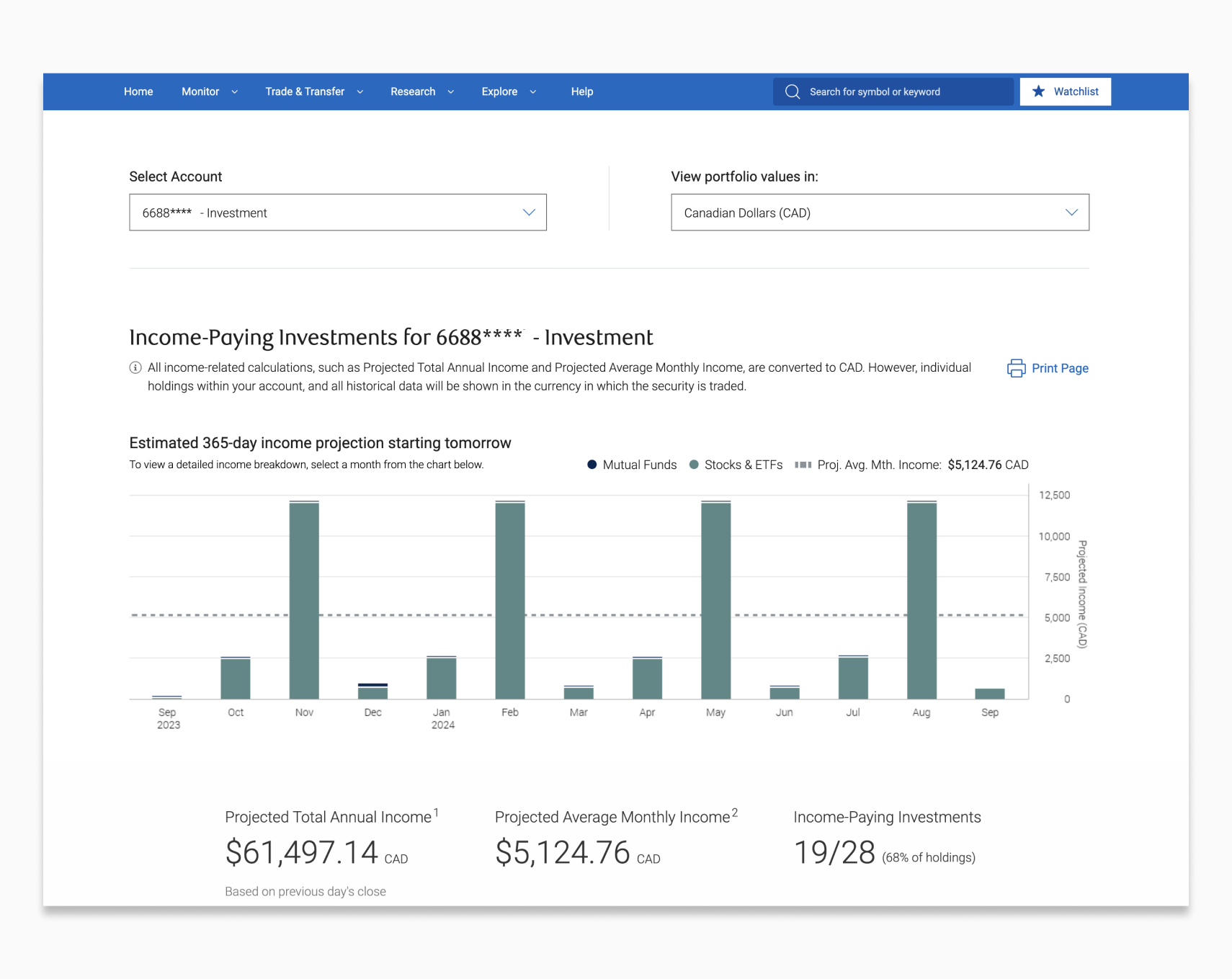
A RRIF is like an extension of your Registered Retirement Savings Plan (RRSP), but instead of putting money in, you withdraw from it for retirement income. The best part? Your investments can continue to grow tax-deferred.
Keep deferring taxes on investment earnings
Withdraw as much or as little retirement income as you wantLegal Disclaimer footnote 1
Choose when to receive your income—from monthly to annually
Age at which you must convert your RRSP to a RRIF or other income sourceLegal Disclaimer footnote 1
Minimum percentage RRIF payout you must take at age 71—it increases every year
Taxes you’ll pay on investment earnings while that money remains in a RRIF (withdrawals are taxed)
While you can’t contribute money to a RRIF, you can switch the types of investments you hold or purchase additional investments with funds that are already in the account.
Use the interactive Income Projection tool to get a simulated estimate of what your dividend and interest income could look like in the future. Select specific accounts to review and get a month-by-month graph of potential returns over the next year.

Enjoy benefits like real-time streaming quotesLegal Disclaimer footnote 3 at no additional cost:

Depending on your needs, you can convert your RRSP to an individual RRIF, spousal RRIF or one of many . Plus, enjoy total freedom to research and pick investments that meet your needs.
Stocks
ETFs
Mutual Funds
GICs
Bonds
Options
Check out Inspired Investor Trade and visit the Investing Academy to learn more about trading and investing in stocks, options, ETFs and more.
Take control of your investments and your retirement income.

You're Protected. Get 100% reimbursement for any unauthorized transactions conducted through the Online Investing platform or the RBC Mobile app.
See the GuaranteeA Registered Retirement Income Fund (RRIF) is a registered plan that provides you with income drawn from the investments and savings in your Registered Retirement Savings Plan (RRSP). RRIFs are similar to RRSPs in that they offer multiple investment options, allow for tax-deferred growth of qualified investments and funds are taxable as income when withdrawn. Unlike RRSPs, however, you can't make new contributions to a RRIF—you can only transfer funds from an RRSP or another RRIF.
You can convert your RRSP (or a portion of it) into a RRIF at any age you wish, but you must transfer all your RRSP funds into a retirement income option by December 31 of the year in which you turn 71.
To learn more, check out Understanding RRIFS: What You Need to Know.
The minimum amount you need to withdraw changes every year; it is based on your age and the market value of your RRIF at year end of the previous year. All withdrawals are taxable. If you have more than one RRIF, each plan will have its own minimum withdrawal.
You can always take more than the minimum; just keep in mind that it is taxable. Talk to your tax advisor about what’s best for you.
If you have a spouse or common-law partner, you can name them as a beneficiary or successor annuitant (not available in Quebec) of your RRIF when you die. Either way, the RRIF will go to your spouse without having to go through probate. Successor annuitant is usually the simpler option — your spouse basically becomes the annuitant of your RRIF and subsequent withdrawals will be taxed to them. If your spouse is named as a beneficiary, your executor will have some flexibility in allocating income tax between your spouse and your estate.
If you do not have a spouse or if you want to name someone other than your spouse, you can specify the beneficiary (or beneficiaries). In this case, the proceeds of your RRIF are withdrawn and paid to the beneficiaries. In provinces with probate fees, naming a beneficiary can reduce those fees.
Estate planning can be complex. If you have financial dependents such as minor children or a disabled adult child/grandchild, speak to an estate planning specialist for more information on naming a successor annuitant or beneficiary on your RRIF.
A life income fund (LIF) is a special RRIF that contains terms prescribed by pension standards legislation. The funds in a LIF are “locked-in.” A LIF can be funded with money transferred from a registered pension plan (RPP). It can also be funded from money that was transferred from an RPP to a locked-in retirement account (LIRA). (A LIRA is a special RRSP that contains terms prescribed by pension standards legislation. The funds in a LIRA are also locked-in. For members of RPPs whose employment rights are governed federally instead of provincially, a LIRA is called a locked-in registered retirement savings plan.)
Like an RRSP, a LIRA terminates at the end of the year you turn 71. Before then, a LIRA must be converted to a LIF or used to buy an annuity. Like a RRIF, a LIF has a minimum amount that must be withdrawn each year. However, unlike a RRIF, a LIF has a cap on how much can be withdrawn in a year. This cap is part of the LIF’s “locking-in” mechanism. LIRAs and LIFs are “locked-in” since they contain money that came from an RPP, and an RPP is intended to pay a pension for life. The LIF’s cap on withdrawals ensures that the LIF will last and not be depleted.
For members of RPPs whose employment rights are governed federally instead of provincially, LIFs and restricted life income funds (RLIFs) are available. An RLIF is also a special RRIF whose funds are “locked-in”, and which imposes a cap on how much can be withdrawn in a year. The main difference between a LIF and an RLIF is that, within 60 days of establishing an RLIF, up to 50% of the RLIF funds can be unlocked and transferred to an RRSP or RRIF.
In Saskatchewan, LIFs are no longer available. Instead, money from a LIRA can be transferred to a prescribed RRIF (PRIF). Like a RRIF and a LIF, a PRIF has a minimum amount that must be withdrawn each year. However, its funds are not locked-in.
In Newfoundland, LIFs and locked-in retirement income funds (LRIFs) are available. An LRIF is also a special RRIF whose funds are “locked-in”, and which imposes a cap on how much can be withdrawn in a year.
In several Canadian jurisdictions, you must have reached a certain age before you can convert a LIRA. You can open a self-directed LIF (RLIF, PRIF or LRIF) with RBC Direct Investing once you have reached that age.
 . You may only use your Avion points through RBC DI to: (1) pay for Canadian or U.S. equity trade commissions on your eligible RBC Direct Investing accounts; or (2) transfer points for cash contributions in CAD to your eligible RBC Direct Investing accounts. It is your responsibility to make sure you have sufficient contribution room within your registered plan when redeeming points for cash contributions in CAD to your registered accounts and/or when you use your Avion points to pay for Canadian or U.S. equity trade commissions on a registered account. The Canada Revenue Agency may apply tax penalties for over-contributions. RBC Direct Investing is not responsible for any such penalties.
. You may only use your Avion points through RBC DI to: (1) pay for Canadian or U.S. equity trade commissions on your eligible RBC Direct Investing accounts; or (2) transfer points for cash contributions in CAD to your eligible RBC Direct Investing accounts. It is your responsibility to make sure you have sufficient contribution room within your registered plan when redeeming points for cash contributions in CAD to your registered accounts and/or when you use your Avion points to pay for Canadian or U.S. equity trade commissions on a registered account. The Canada Revenue Agency may apply tax penalties for over-contributions. RBC Direct Investing is not responsible for any such penalties.